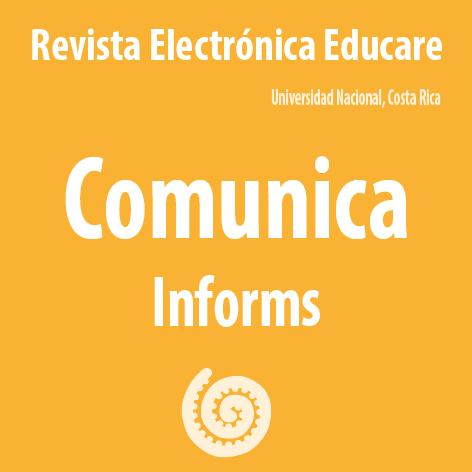Avaliação do treinamento permanente em práticas de restauração
DOI:
https://doi.org/10.15359/ree.24-2.14Palavras-chave:
Formação permanente, práticas restaurativas, escolas saudáveis, formação de professoresResumo
O objetivo desta pesquisa é mostrar o impacto de ações formativas sobre práticas restaurativas num grupo de professores que desconhecem o assunto. O objetivo é coletar e comparar as concepções sobre conflitos e sua abordagem dos sujeitos participantes do treinamento antes que ela ocorra e uma vez terminada. Ao mesmo tempo, pretende-se analisar o papel desempenhado pelas estratégias de formação na mudança de concepções.
Referências
Abraham, R., Ramnarayan, K., & Kamath, A. (2008). Validating the effectiveness of Clinically Oriented Physiology Teaching (COPT) in undergraduate physiology curriculum. BMC Medical Education, 8(40), 1-5. https://doi.org/10.1186/1472-6920-8-40
Associació de Justícia i Pràctica Restaurativa. (2016). Associació de Justícia i Pràctica Restaurativa de les Illes Balears. https://sites.google.com/a/practicarestaurativa.org/associacio-de-justicia-i-practica-restaurativa/el-centre
Braithwaite, J. (2002). Restorative justice and responsive regulation. Oxford University Press.
Braithwaite, J. (2006). Doing justice intelligently in civil society. Journal of Social Issues, 62(2), 393-409. https://doi.org/10.1111/j.1540-4560.2006.00456.x
Britto, D. (2006). Justicia restaurativa, otra forma de establecer disciplina. Justicia Restaurativa en Línea.
Cortina, J. M. (1993). What is coefficient alpha? An examination of theory and applications. Journal Applied Psycholofy, 78(1), 98-104. https://doi.org/10.1037/0021-9010.78.1.98
Costello, B., Wachtel, J., & Wachtel, T. (2009). The restorative practices handbook for teachers, disciplinarians and administrators. International Institute for Restorative Practices.
Costello, B., Wachtel, T., & Wachtel, J. (2010). Restorative circles in schools: Building community and enhancing learnig. International Institute for Restorative Practices.
Crowne, D. P., & Marlowe, D. (1964). The approval motive: Studies in evaluative dependence. Wiley.
Degani, A.T., Patel, R. M., Smith, B. E., & Grimsley, E. (2009). The effect of student training on accuracy of completion of death certificates. Medical Education Online, 14(1), 1-5. https://doi.org/10.3402/meo.v14i.4510
Entwistle, N. (1998). Conceptions of learning. Understanding and teaching in higher education. Scre Fellowship Lecture.
Feuillette-Cunningham, I. (1995). Le nouveau formateur. Comment preparer, animer et évaluer une action de formation. Dunod.
Gray, S., & Drewery, W. (2011). Restorative practices meet key competencies: Class meetings as pedagogy. International Journal on School Disaffection, 8(1) 13-21. https://doi.org/10.18546/IJSD.08.1.03
Hall, M., Ramsay, A., & Raven, J. (2004). Changing the learning environment to promote deep learning approaches in first-year accounting students. Journal Accounting Education, 13(4), 489-505. https://doi.org/10.1080/0963928042000306837
Hopkins, B. (2004). Just schools: A whole school approach to restorative justice. Jessica Kingsley.
Hopkins, B. (2011). The restorative classroom. Using restorative approaches to foster effective learning. Optimus Education.
International Institute for Restorative Practices. (2019). Restoring Community. https://www.iirp.edu/
Johnstone, J. W. C., & Rivera, R. J. (1965). Volunteers for learning. A study of the educational pursuits of American adults. Aldine.
Jurado, P. (1996). Requisits de l’aprentatge. UOC.
McCluskey, G, Lloyd, G., Kane, J., Riddell, S., Stead, J., & Weedon, E. (2008). Can restorative practices in schools make a difference? Educational Review, 60(4), 405-417. https://doi.org/10.1080/00131910802393456
McCold, P., & Wachtel, T. (2003). In pursuit of paradigm: A theory of restorative justice. Restorative Practices EForum. https://www.iirp.edu/news/in-pursuit-of-paradigm-a-theory-of-restorative-justice
Mirsky, L. (2011). Restorative practices: Giving everyone a voice to create safer Saner School Communities. The Prevention Researcher, 18(5), 3-6. https://doi.org/10.1037/e542592012-002
Morrison, B. (2006). School bullying and restorative justice: Toward a theoretical understanding of the role of respect, pride, and shame. Journal of Social Issues, 62(2), 371-392. https://doi.org/10.1111/j.1540-4560.2006.00455.x
Morrison, B., Blood, P., & Thorsborne, M. (2005). Practising restorive justice in school communities: Addresdsing the challenge of culture change. Public Organisation Review, 5(4), 335-357. https://doi.org/10.1007/s11115-005-5095-6
Reimer, K. (2011). An exploration of the implementation of restorative justice in an Ontario public school. Canadian Journal of Educational Administration and Policy, 119, 1-42. https://eric.ed.gov/?id=EJ923619
Schmitt, N. (1996). Uses and abuses of coefficient alpha. Psychological Assessment, 8(4), 350-353. https://doi.org/10.1037/1040-3590.8.4.350
Streiner, D. L. (2003). Starting at the beginning: An introduction to coefficient alpha and internal consistency. Journal of Personality Assessment, 80(1), 99-103. https://doi.org/10.1207/S15327752JPA8001_18
Vaandering, D. D. (2013). Student, teacher, and administrator perspectives on harm: Implications for implementing safe and caring school initiatives. Review of Education, Pedagogy, and Cultural Studies, 35(4), 298-318. https://doi.org/10.1080/10714413.2013.825514
Vaandering, D. D. (2014). Implementing restorative justice practice in schools: What pedagogy reveals, Journal of Peace Education, 11(1), 64-80, https://doi.org/10.1080/17400201.2013.794335
Woolfolk, A. E., & MacCuna, L. (1980). Educational psychology for teachers. Prentice-Hall.
Zehr, H. (2005). Changing lenses: A new focus for crime and justice (3rd ed.). Herald Press.
Downloads
Publicado
Como Citar
Edição
Seção
Licença
- Caso o artigo seja aceito para publicação, os autores permitem a cessão GRATUITA, EXCLUSIVA E INDEFINITA de seus direitos patrimoniais à Universidade Nacional (UNA, Costa Rica). Para obter mais detalhes, consultar a Carta de originalidade e cessão de direitos.
- Direitos de reutilização: a UNA concede aos AUTORS(AS) o direito de reutilizar para qualquer propósito, incluindo o auto arquivo, e a publicação na Internet ou em qualquer website da versão final aprovada e publicada (post print) do artigo, desde que seja feita para fins não lucrativos, não gere trabalho derivado sem autorização prévia e respeite as fontes de autoria.
- A oferta e possível publicação do artigo na Revista Electrónica Educare reger-se-á pelas suas políticas editoriais, pela regulamentação institucional da Universidade Nacional e pela legislação da República da Costa Rica. Além disso, quaisquer divergências futuras de opinião ou disputa serão resolvidas de acordo com os mecanismos de Resolução Alternativa de conflitos e a Jurisdição da Costa Rica.
- Em todos os casos, entende-se que as opiniões emitidas são de responsabilidade dos autores e não refletem necessariamente a posição e a opinião da Educare, CIDE ou da Universidade Nacional, Costa Rica. Entende-se também que, no exercício da liberdade acadêmica, os autores realizaram um rigoroso processo científico-acadêmico de pesquisa, reflexão e argumentação e que se enquadra na área temática de interesse da Revista.
- Os artigos publicados pela Revista Eletrônica Educare utilizam a Licença Creative Commons:














 The articles published by Educare Electronic Journal can be shared with a Licença Creative Commons :
The articles published by Educare Electronic Journal can be shared with a Licença Creative Commons : 



